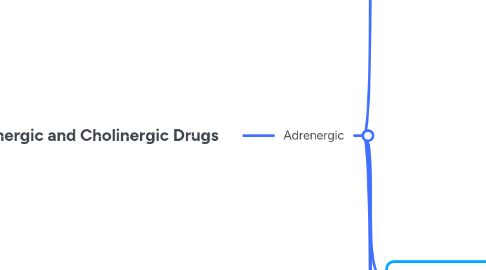
1. Cholinergics
1.1. Cholinomimetic
1.1.1. Direct acting
1.1.1.1. Muscarinic
1.1.1.1.1. Choline Esters
1.1.1.1.2. Alkaloids
1.1.1.2. Nicotinic
1.1.2. Indirect acting-inhibits ACHe
1.1.2.1. Short acting-usually alcohol types (-OH)
1.1.2.1.1. Duration of Action: 15-30 mins ⚫ Chemical: Aminoalcohol ⚫ Interaction with Acetylcholinesterase: Reversible
1.1.2.2. Intermediate acting(-STIGMINE)
1.1.2.2.1. Duration of Action: 2-8 hours ⚫ Chemical: Carbamates ⚫ Interaction with Acetylcholinesterase: Reversible
1.1.2.3. Long acting
1.1.2.3.1. Duration of Action: > 24 hours ⚫ Chemical: Organophosphates ⚫ Interaction with Acetylcholinesterase: Reversible (1-2 days); Irreversible (>48 hrs)
1.2. Parasympatholytics/Cholinergic Antagonists
1.2.1. Antimuscarinic
1.2.1.1. Non selective
1.2.1.1.1. Atropine
1.2.1.2. M1-selective
1.2.1.2.1. Pirenzepine
1.2.2. Antinicotinic
1.2.2.1. Ganglion (Nicotinic) blockers
1.2.2.1.1. Hexamethonium, Trimetaphan, Mecamylamine
1.2.2.2. Neuromuscular blockers
1.2.2.2.1. Tubocurarine
1.2.3. Cholinesterase regenerators
1.2.3.1. Oximes
1.2.3.1.1. Pralidoxime
1.3. Other Drugs: Based on Site of Action
1.3.1. CNS-FOR PARKINSONS
1.3.1.1. Scopolamine
1.3.1.1.1. Motion sickness
1.3.1.2. Benztropine,Bipyriden, and trihexyphenidyl
1.3.2. Eyes
1.3.2.1. Homatropine,Anistropine,Cyclopentolate, Tropicamide
1.3.3. Bronchi- for Asthma and COPD
1.3.3.1. Ipratropium Tiotropium Aclidinium – Long-acting
1.3.4. GIT
1.3.4.1. Pirenzepine & Telenzepine – M1 selective blocker
1.3.4.2. Methscopolamine, Propantheline – obsolete for acid-peptic disease
1.3.5. Urinary Bladder-Urinary incontinence
1.3.5.1. ⚫ Methscopolamine, ⚫ Scopolamine ⚫ Dicycloverine ⚫ Hyoscine-MOST USED ⚫ Oxybutynin ⚫ Glycopyrrolate
2. Adrenergic
2.1. Direct Acting- directly binds to Adrenergic receptors
2.1.1. Non selective sympa(NE,EPI,DOPA)
2.1.1.1. NE
2.1.1.1.1. Inotropic agent for septic shock
2.1.1.2. EPI
2.1.1.2.1. Cardiac stimulant(b1), Anaphylaxis (b2), local vasoconstrictor(longer anesthetic action, glaucoma mngmt
2.1.1.3. DOPA
2.1.1.3.1. 1-3 ug/kg/min: d1,inc gfr and diuresis
2.1.1.3.2. 2-5 ug/kg/min: b1, inc inotropy,chrono,dromo
2.1.1.3.3. >5ug/kg/min:a1, vasoconstriction
2.1.1.3.4. Dopa toxicity: -> Alpha-1 Overstimulation = vasoconstriction -> Beta -1 Overstimulation = Tachyarrythmias (Increased HR with irregular heart rhythm)
2.1.1.3.5. Management of cardiogenic shock and septic shock; Management of Acute HF with Oliguria or Anuria
2.1.2. Selective sympa
2.1.2.1. Non selective b agonist(activates both b1 and b2)
2.1.2.1.1. Isoproterenol/isoprenaline
2.1.2.2. Selective b1 agonist
2.1.2.2.1. Dobutamine
2.1.2.3. Selective b2 agonist
2.1.2.3.1. Short acting (SABA)
2.1.2.3.2. Long acting (LABA)
2.1.2.3.3. Tocolytics
2.1.2.4. Selective a1 agonist
2.1.2.4.1. Phenylephrine, Propylhexedrine Methoxamine, Naphazoline, Oxymetazoline, and Tetrahydrozoline
2.1.2.5. Selective a2 agonist
2.1.2.5.1. Effects: ✔ Pre-synaptic: autoregulation –self-regulating • Central: Sedation, Depression • Peripheral: Vasodilation ✔ Post-synaptic: vasoconstriction
2.1.2.6. Selective d1 agonist
2.1.2.6.1. Fenoldopam
2.2. Indirect Acting- inc SE by inc NE release and NE reuptake inhibition
2.2.1. Release NE through exocytosis Ex: Tyramine, Ephedrine, Amphetamine, Alpha-latrotoxin, Angiotensin II
2.2.2. ReuptakeInhibitors Ex: Cocaine, TCA, REBOXETINE(NE-Reuptake Inhibitor)
2.2.3. Side-effect of Ephedrine: o Hypertension Exacerbation o Precipitates urinary retention o Tachyarrhythmia
2.3. Centrally Acting- acts on cns
2.3.1. Phenylpropanolamine, Phentermine, Phenmetrazine, Amphetamine, Methylphenidate
2.3.1.1. USES: Management of ADHD o 1st line: METHYLPHENIDATE o Alternative: AMPHETAMINE Anorexiants – APPETITE SUPPRESSANTS (Phentermine, Phenmetrazine, Phenylpropanolamine) Management of Narcolepsy –SLEEPINESS (Phentermine & AMPHETAMINE)
2.3.1.2. Side Effects: o Risk of addiction o Risk of Hemorraghic Stroke (PHENYLPROPANOLAMINE) o Risk of Pulmonary Hypertension (PHENTERMINE)
2.4. Sympatolytics
2.4.1. Alpha blockers Effects: Vasodilation; Relief of urinary retention (difficulty in urination)
2.4.1.1. Non selective a blockers
2.4.1.1.1. Acts of alpha 1 and 2 receptors ⚫ Example: o Phenoxybenzamine (Irreversible or permanent blocker) o Phentolamine (Reversible blocker)-safer
2.4.1.1.2. Mngmt of phaeochromocytoa
2.4.1.2. Selective a1 blockers
2.4.1.2.1. Acts on ALPHA 1 only (-zosins) ⚫ Example: o Alfuzosin o Doxazosin o Prazosin o Tamsulosin o Terazosin
2.4.1.2.2. Mngmt of raynaud’s syndrome
2.4.1.2.3. Mngmt of urinary retention in BPH
2.4.1.3. Select a2 blockers
2.4.2. Beta blockers
2.4.2.1. NS b blockers
2.4.2.1.1. Block Beta-1 and Beta-2 receptors ⚫ Exhibits BRONCHOCONSTRICTION effect on the lungs. ⚫ Examples: (NSTP) ⚫ Nadolol ⚫ Sotalol ⚫ Timolol-glaucoma mngmt ⚫ Propranolol-hyperthyroidism,stage fright, prophylaxis of migraine
2.4.2.2. Selective b1 blockers
2.4.2.2.1. Examples: (CAMBABE) Celiprolol Betaxolol-glaucoma mngmt Bisoprolol-stable heart failure Atenolol Acebutolol Metoprolol-stable heart failure ESMOLOL
2.4.2.3. B blockers w/ intrinsic activity
2.4.2.3.1. Contains alpha agonist effects
2.4.2.4. B blockers w a1 blocking effect
2.4.2.4.1. Labetalol and carvedilol
2.4.2.5. Beta-Blockers with Membrane Stabilizing Action
2.4.2.5.1. Includes local anesthetic effect
